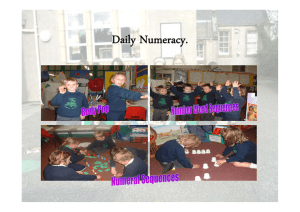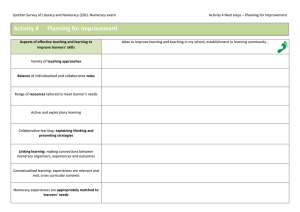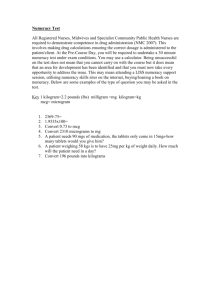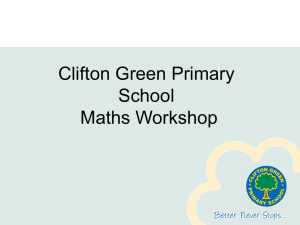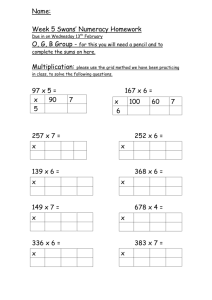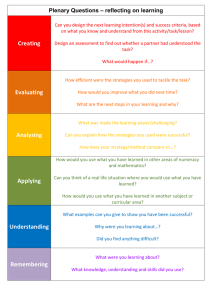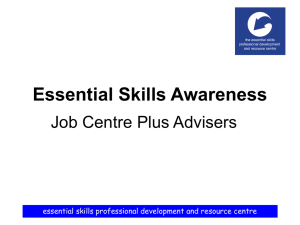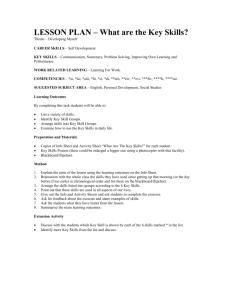mathcentre community project community project Approaching Numeracy as an Adult
advertisement
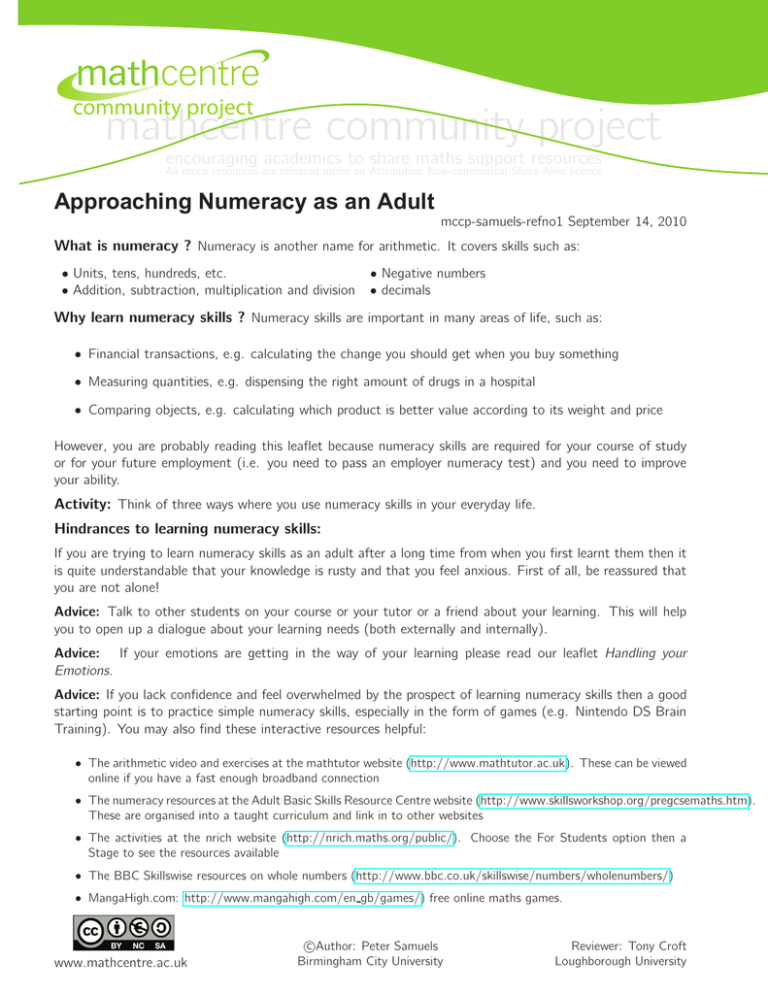
community project mathcentre community project encouraging academics to share maths support resources All mccp resources are released under an Attribution Non-commerical Share Alike licence Approaching Numeracy as an Adult mccp-samuels-refno1 September 14, 2010 What is numeracy ? Numeracy is another name for arithmetic. It covers skills such as: • Units, tens, hundreds, etc. • Addition, subtraction, multiplication and division • Negative numbers • decimals Why learn numeracy skills ? Numeracy skills are important in many areas of life, such as: • Financial transactions, e.g. calculating the change you should get when you buy something • Measuring quantities, e.g. dispensing the right amount of drugs in a hospital • Comparing objects, e.g. calculating which product is better value according to its weight and price However, you are probably reading this leaflet because numeracy skills are required for your course of study or for your future employment (i.e. you need to pass an employer numeracy test) and you need to improve your ability. Activity: Think of three ways where you use numeracy skills in your everyday life. Hindrances to learning numeracy skills: If you are trying to learn numeracy skills as an adult after a long time from when you first learnt them then it is quite understandable that your knowledge is rusty and that you feel anxious. First of all, be reassured that you are not alone! Advice: Talk to other students on your course or your tutor or a friend about your learning. This will help you to open up a dialogue about your learning needs (both externally and internally). Advice: If your emotions are getting in the way of your learning please read our leaflet Handling your Emotions. Advice: If you lack confidence and feel overwhelmed by the prospect of learning numeracy skills then a good starting point is to practice simple numeracy skills, especially in the form of games (e.g. Nintendo DS Brain Training). You may also find these interactive resources helpful: • The arithmetic video and exercises at the mathtutor website (http://www.mathtutor.ac.uk). These can be viewed online if you have a fast enough broadband connection • The numeracy resources at the Adult Basic Skills Resource Centre website (http://www.skillsworkshop.org/pregcsemaths.htm). These are organised into a taught curriculum and link in to other websites • The activities at the nrich website (http://nrich.maths.org/public/). Choose the For Students option then a Stage to see the resources available • The BBC Skillswise resources on whole numbers (http://www.bbc.co.uk/skillswise/numbers/wholenumbers/) • MangaHigh.com: http://www.mangahigh.com/en gb/games/) free online maths games. www.mathcentre.ac.uk c Author: Peter Samuels Birmingham City University Reviewer: Tony Croft Loughborough University You may lack motivation because you feel that numeracy skills are not relevant to your chosen course of study or career and you can’t understand why you have to improve them. If so then there are many good text books available that teach numeracy skills in context such as: mathcentre community project • R. A. Brechner, Contemporary Mathematics for Business and Consumers, 2005, Thomson Learning • C. Chapelhow & S. Crough, Nursing Numeracy: A New Approach, 2006, Nelson Thornes encouraging academics to share maths support resources Other challengesAll inmccp learning numeracy resources are released skills: under an Attribution Non-commerical Share Alike licence Once you have started to address your confidence, anxiety and motivational needs, there are other ways that you may struggle when learning numeracy skills: Incremental development: numeracy skills are made up from concepts which depend upon each other. You may have difficulty understanding a new concept because there is a gap in your knowledge. Example: Drug calculations for nurses are based on fractions, ratios, decimals and units. If you are trying to learn how to do drug calculations you should first try to gain fluency in each of these individual skills before you attempt to use them together. Estimation: The ability to estimate values can be really helpful when you are trying to improve your numeracy skills. This is because numeracy is a combination of concepts and processes: if you concentrate too much on learning processes then you may not realise when your answers don’t make sense. Advice: Try to get a feel for the size of numbers within a question so that you can estimate the size of the solution. You may benefit from trying to visualise the numbers in terms of real objects. Converting between different units: A common misunderstanding is not knowing when to multiply and when to divide. Example: When converting 10kg into grams, because a gram is 1,000 times smaller than a kilogram you may think that you need to divide the 10 by 1,000, giving you 0.01g, rather than multiply the 10 by 1,000 to give you 10,000g (which is the correct answer). However, being able to visualise how big 10kg, 0.01g and 10,000g are in terms of real objects should help to overcome this misconception: you could think of ten bags of frozen peas, each containing 1,000 peas and each bag weighing 1kg. Then it should be clear that 10kg cannot be the same as 0.01g because this would weigh a lot less than one pea! Operations on numbers between 0 and 1: this is a concept that many people struggle with. It can occur in fractions, decimals or percentages when using multiplication or division. Advice: Try to visualise numbers between 0 and 1 as part of a whole, such as a circle. 1 This shaded area represents: , or 0.25 or 25% 4 Advice: The following rules may help you: • If you multiply by a number between 0 and 1 then the result should be smaller than the original number • If you divide by a number between 0 and 1 then the result should be larger than the original number Example: What is 0.3 × 0.3? If you think the answer is 0.9, use one of the rules above to show that this cannot be the case. If you find this confusing then you may have an incorrect concept of multiplying decimals (e.g. you’re multiplying 3 by 3 then inserting the decimal point in front). To remedy this, draw a square 1m by 1m with smaller squares 0.1m by 0.1m inside. 1 of the area, i.e. 0.01. Then draw a There are 100 small squares, so each one represents 100 square measuring 0.3m by 0.3m and count the number of small squares. There are nine small squares and 9 × 0.01 = 0.09. Suggested reading: G. Lawler, Understanding Maths: Basic maths explained, 2007, 3rd rev. edition, Studymates Ltd. www.mathcentre.ac.uk c Author: Peter Samuels Birmingham City University Reviewer: Tony Croft Loughborough University
